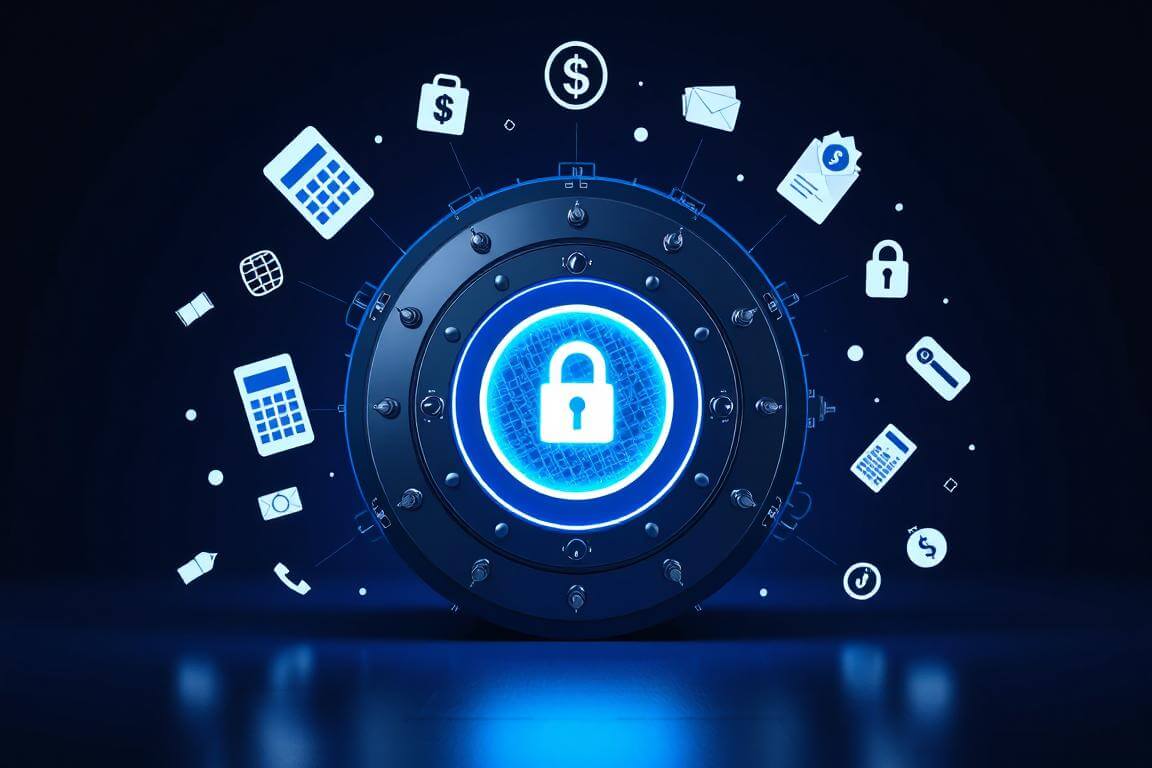Tax season, budgeting, investing, bill negotiation — AI has slashed the grind on all of them. But with convenience comes risk: financial data is sensitive, and handing it to apps or bots without due care is like leaving your treasure chest unlocked on a busy dock. This guide is for people who want to use AI to manage money without sacrificing privacy or control. It’s practical, actionable, and built for the kind of freelance/small-business life most of us sail: messy, busy, and needing tools that actually save time.
What you’ll get:
- Clear privacy-first rules for picking and configuring AI finance tools.
- A step-by-step secure setup (email, devices, bank connections, backups).
- Tool-level recommendations and configuration tips.
- Advanced options (on-device/self-hosted, encryption, differential privacy).
- Actionable prompts, templates, and a 30/60/90 plan to implement everything.
💡Personal Note: I’ve tested dozens of finance tools across freelancing seasons and client work. I once lost hours combing receipts; now a lean, privacy-first AI setup saves me time and keeps the sensitive stuff under lock and key. This guide organizes what I actually use and what I teach clients.
Why privacy matters in AI + finance (and the real risks) 🏦🔐
AI apps need data. The better they are, the deeper they often dive — transactional records, merchant names, recurring charges, even geolocation metadata. That’s useful for features (automated categorization, deduction spotting), but it’s the same data identity thieves and shady advertisers want.
Key risks to understand:
- Data exposure — breaches happen. Even “trusted” platforms have had incidents.
- Overpermissioning — giving apps the right to move money (or write transactions) when they only need view access.
- Third-party sharing — “anonymized” data still gets resold or stitched together for profiling.
- Phishing & clone apps — fake apps that mimic a legit product and harvest credentials.
Real impact: identity theft, unauthorized transfers, targeted scams, and long cleanup times.
Why “read-only” connections matter: read-only bank access (via a tokenization layer like Plaid/TrueLayer) lets tools see transactions without having credentials to move money. For most AI features — categorization, deduction detection — read-only is sufficient.
💡Personal Note: The first AI budgeting tool I installed asked for full account permissions. I paused, investigated their policy, and switched to a read-only approach. That one change prevented a heartache I never had to prove.
The privacy-first decision tree (how to choose and trust tools) 🧭
Before you install anything, run it through a short checklist:
1) Does the tool need the data it requests?
If it’s a receipt scanner or budgeter, it likely only needs transaction visibility — not permission to move funds. If a feature truly requires write access (automatic bill pay, auto-transfer) treat it like a privilege: only enable after you’ve vetted the provider.
2) What do they say about data retention and sharing?
Read the privacy policy (yes, actually read it). Look for:
- Explicit “no-sell” clauses.
- Retention windows (how long data is kept).
- Whether derivative data (models trained on user data) is allowed.
3) Security badges: do they exist, and are they current?
Look for SOC 2, ISO 27001, or similar. Those aren’t perfect, but they indicate the company has formal security practices.
4) Do they offer encryption + MFA?
At minimum: TLS in transit, encryption at rest, and multi-factor authentication.
5) Customer support & corporate identity
If the app is new and offers no support or corporate identity, be wary. Real companies have verifiable leadership, support channels, and a responsive privacy team.
6) Can I trial with fake or limited data?
Some tools let you connect sandbox/test accounts. Use those first.
💡Personal Note: I always test new finance apps with a “fake” account or a low-risk card and a new finance-only email. It reveals whether an app behaves professionally before I plug in anything important.
A practical, privacy-first setup (step-by-step — do this in the next weekend) 🛠️
This is the exact, practical checklist I tell clients to implement over a weekend. I break it into device, account, and tool configuration.
Device hygiene (30–60 minutes)
- Update OS & apps — ensure latest security patches.
- Enable full-disk encryption (FileVault on macOS, BitLocker on Windows).
- Install a password manager (1Password, Bitwarden) and use a unique, strong master password.
- Turn on device biometrics + device PIN.
- Remove unused apps and disable unneeded permissions (location, microphone) for finance apps.
💡Personal Note: I once kept an old test phone with saved credentials. That’s how a small breach turned into a two-day cleanup. Updating and scrubbing prevented that lesson from repeating.
Account hygiene (30–45 minutes)
- Create a dedicated finance email (e.g., finance@yourdomain.com or a Gmail alias). Use that for connecting banks, accounting apps, and your CPA. Keeps notifications centralized.
- Enable two-factor authentication (2FA) for the finance email, password manager, and banking portal. Use hardware keys (YubiKey) where supported.
- Use separate logins for personal and business finances. Don’t reuse passwords.
Bank & aggregator connections (15–30 minutes)
- Prefer tokenized, read-only connections (Plaid, TrueLayer, etc.) vs. sharing raw credentials.
- If a provider asks you to upload bank statements rather than connect, that can be safer (manual, more effort, but less exposure).
- Keep an eye on transaction sync: review first 24 hours and watch for unexpected activity.
Tool selection & configuration (2–3 hours)
- Choose a primary ledger: QuickBooks Online, Wave, Xero, or a spreadsheet for early days.
- Pick a receipt capture tool: Expensify, Dext, or using your phone + cloud storage.
- Configure auto-categorization rules for: subscriptions, payroll, platform fees, shipping, and recurring costs.
- Set up a monthly reminder to review flagged items (15–30 minutes).
💡Personal Note: For my first clients I set aside 2 hours to connect accounts and create 10 category rules — that one session removed 70% of manual corrections for the rest of the year.
Tool deep dive — categories, configuration tips, and exact prompts ⚙️
Below are common categories of AI finance tools, how to configure them with privacy in mind, and example prompts for AI helpers.
Receipt capture & OCR (Expensify / Dext / mobile scans)
- Privacy tip: Use their mobile app with local photo processing when possible; if the app clouds images, ensure encryption at rest. Popular options like Expensify or Dext handle receipt scanning with solid policies if configured correctly
- Config: Turn on auto-scan, set the upload folder to a finance-only cloud bucket, and enable auto-delete after X years if policy allows.
- Prompt (OCR cleanup):
Extract vendor, date, amount, tax (if present), and line items from this receipt OCR text. Return as CSV: Date,Vendor,Amount,Tax,Items.
Automatic categorization (QuickBooks, Wave, Zoho)
- Privacy tip: Use rules and local label vocab rather than relying solely on ML. Rules are controllable and auditable.
- Config: Create rules for frequent vendors (Shopify → COGS, Paypal → Payment fees). Keep a weekly review queue.
- Prompt (bulk categorization for ChatGPT):
You are a tax assistant. Categorize these transactions into Schedule C categories and mark uncertain ones with “REVIEW”. Output: Date, Merchant, Amount, SuggestedCategory, Notes.
Deduction finders (Keeper Tax, TurboTax AI helpers)
- Privacy tip: Check for policy on using data to train models. Opt-out if you don’t want your transactions used for training.
- Config: Run monthly scans with tools such as Keeper Tax or TurboTax’s AI helper, export flagged items as an encrypted PDF, redact long account numbers before external sharing.
- Prompt (deduction audit):
Analyze this transaction list for deductible items for a US sole proprietor. Group by category and estimate deductible amounts.
Investment & robo tools (Robo-advisors, AI stock screeners)
- Privacy tip: Use established custodians; for AI stock screeners, avoid uploading full brokerage credentials — export and upload only necessary holdings if possible.
- Config: Keep investment trading accounts separate from spending accounts. If you use an AI screener, limit it to read-only holdings snapshots.
- Prompt (screener safe use):
Given these public ticker holdings and trade history (no account credentials), identify overconcentration risks and suggest rebalancing ideas that consider a 5% tax-loss harvesting threshold.
ChatGPT/LLM workflows (prompts, CSVs, summaries)
- Privacy tip: Never paste raw account numbers, SSNs, or full bank statements into public LLMs. Redact or replace with placeholders.
- Config: Use local or enterprise LLM instances when possible; set up a small pipeline where you sanitize data first (scripted redaction).
- Prompt (privacy-aware summary):
Summarize these categorized transactions (redacted account IDs) into: total income, total deductible expenses, top 5 categories, and suggested follow-ups for CPA.
💡Personal Note: I run a two-stage flow: (1) script scrubs raw values and replaces account digits with Xs, (2) paste sanitized CSV into the LLM for analysis. It’s an extra step but reduces risk dramatically.
Privacy tip: Never paste raw account numbers, SSNs, or full bank statements into public LLMs. Redact or replace with placeholders.
Config: Use local or enterprise LLM instances when possible; set up a small pipeline where you sanitize data first (scripted redaction).
Prompt (privacy-aware summary):
Summarize these categorized transactions (redacted account IDs) into: total income, total deductible expenses, top 5 categories, and suggested follow-ups for CPA.
💡Personal Note: I run a two-stage flow: (1) script scrubs raw values and replaces account digits with Xs, (2) paste sanitized CSV into the LLM for analysis. It’s an extra step but reduces risk dramatically.
Advanced privacy techniques — for power users & businesses 🔐⚙️
If you want to go beyond basic hygiene, these techniques tighten the vault. They’re more complex, and some require technical support — but they’re worth it if you handle high volumes or highly sensitive data.
Self-hosted or private LLMs (on-prem / cloud VPC)
- Running an LLM in your own cloud VPC or on a local machine means your prompts and data don’t traverse public LLM endpoints. Tools: Llama-based local deployments, enterprise LLM offerings with private inference.
- Tradeoffs: Higher setup cost, maintenance, and slower iteration, but much stronger privacy control.
Homomorphic encryption & secure enclaves (conceptual)
- These are advanced techniques allowing computation on encrypted data. Not yet mainstream for small business tax workflows but being piloted at large firms. Keep an eye on developments if you manage extremely sensitive data.
Differential privacy & model opt-out
- Some services let you opt-out of having your data used to train models (differential privacy, opt-out terms). If available, use it.
Air-gapping & manual review for high-value docs
- For critical documents (SSNs, tax returns), keep local encrypted copies and only provide redacted exports to cloud tools. Use encrypted transfer (S-FTP or secure client portals) for your CPA.
💡Personal Note: I helped one small startup set up a VPC private LLM for payroll analysis. It was a stretch, but the peace of mind for payroll privacy was worth the engineering time.
Working with accountants & advisors safely 🤝🧾
AI speeds up organization, but professionals still matter. Here’s how to hand off tidy, privacy-minimized packages to CPAs without exposing extra sensitive information.
What to export and how
- Export CSV of transactions, a PDF summary of deductions, and a receipts folder (all zipped).
- Redact full account numbers (show last four digits only).
- Encrypt the zip with a password, and share the password via voice call or a separate channel.
Secure communication
- Use encrypted client portals (many CPA firms offer them), or tools like SecureDrop / Tresorit / ShareFile. Avoid emailing unencrypted files.
Minimal data principle
- Give pros the minimum data they need to do the job. If they only need totals, don’t send raw transaction-level exports.
Sample email subject/body for sending to CPA:
Subject: 2025 Year-End Export (Encrypted) — [YourName]
Hi [CPA Name], attached is my encrypted export for 2025.
Included: CSV transactions, deduction summary PDF, receipts folder.
Password: I’ll call/text to share the password.
Notes: [list any unusual items]
Thanks — [Your Name]
💡Personal Note: My CPA prefers passworded zips and a five-minute call to receive the password — it’s quick and stops accidental leaks.
Scams & red flags — what to watch for and how to react 🦈
Scammers love “AI” in marketing. Here are the most common scams and how to spot them:
Fake robo-advisor & guaranteed returns
- Red flag: Promises of guaranteed returns or “risk-free” AI trading. No honest service guarantees markets.
- Action: Search for FINRA registration, custodian names, and real user reviews.
Credential harvesters & clone apps
- Red flag: Ads linking to lightweight landing pages with copycat logos, or apps with very few reviews.
- Action: Only download apps from official app stores and verify developer info.
Overly broad permissions
- Red flag: An app requests permission to “manage your bank” when it only needs to read transactions.
- Action: Deny write permissions and choose read-only tokens.
Hidden data resale
- Red flag: Broad “we may share anonymized data” language in the privacy policy with no opt-out.
- Action: Look for explicit “no-sell” terms or a data opt-out.
💡Personal Note: A client nearly wired money to a scammy “AI invoice manager.” Quick verification of vendor documents and a phone call stopped a six-figure loss.
30/60/90 plan — how to implement this safely over time ⏱️
Don’t try to secure everything in one day. Here’s a prioritized rollout you can follow.
Week 1 (30 days: stopgap + quick wins)
- Create finance-only email; enable 2FA.
- Install a password manager, change critical passwords.
- Move recurring subscriptions into one card you track.
- Connect bank read-only to your chosen ledger.
Month 2 (60 days: automation + review)
- Set up receipt capture and 10 category rules.
- Run monthly deduction scans and export redacted summaries.
- Add hardware key for your primary finance accounts if possible.
Month 3 (90 days: hardening & pro handoff)
- Create encrypted backups and retention policy.
- Test a mock handoff to your CPA (export, redact, transfer).
- Evaluate self-hosted or private LLM options if you need them.
💡Personal Note: I teach this cadence to clients — incremental changes stick better than a one-time overhaul. After 90 days most folks are comfortable and in a rhythm.
Prompts bank & templates (copy/paste ready) 🧾🤖
Use these sanitized prompts in ChatGPT or enterprise LLMs — never paste raw account numbers or full SSNs.
Categorize CSV (for LLM)
You are a tax assistant. Given this CSV (Date, Merchant, Amount, Description), categorize each line into IRS Schedule C categories, mark uncertain rows as REVIEW, and provide totals per category.
Find deductible subscriptions
Review this list of subscriptions (vendor, monthly price, usage notes). Highlight subscriptions used >50% for business and estimate annual deductible amount.
Create a CPA summary
Create a one-page summary of year-to-date income and deductions, highlight top three categories, and list unusual transactions that may require CPA review.
Redaction script (example for developers)
Replace any sequence of >10 digits with [REDACTED_ACCOUNT]. Preserve last 4 digits when found adjacent to “acct” or “account”.
FAQ — quick answers for busy captains ❓
Can I use ChatGPT with my raw bank statements?
Never paste full, unredacted bank statements into a public LLM. Sanitize data first or use private/enterprise LLMs.
What if AI miscategorizes something?
Correct it — most systems learn. Maintain a weekly review cadence.
How long should I keep backups?
Follow local tax authority rules (often 3–7 years). Keep encrypted backups and a separate offline copy.
Is on-device AI worth it?
If you handle very sensitive data or high volumes, on-device or private LLMs are worth exploring. For most freelancers, cloud tools with strong policies suffice.
Final thoughts — balance convenience with control ⚖️🏝️
AI gives you an enormous productivity advantage in personal finance: faster categorization, better deduction discovery, and cleaner handoffs to professionals. But privacy and control must be first principles. Treat AI as your first mate — do the repetitive work and surface findings — but keep the captain’s wheel (critical decisions, credentials, and large transfers) under your direct control.
💡Personal Closing Note: When I balanced convenience with privacy controls (finance-only email, read-only bank tokens, monthly review), tax season went from a hurricane to a calm sea. You don’t have to be paranoid — just reasonable, methodical, and deliberate. (For more resources, see FTC guidance on protecting your privacy online.)



